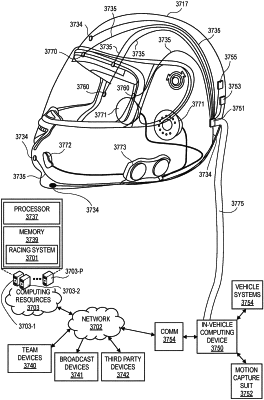| CPC A42B 3/30 (2013.01) | 17 Claims |

|
1. A helmet configured to be worn by a first user, comprising:
an augmented reality (“AR”) interface configured to visually present identifiers indicating an identity, position or other information about one or more users;
one or more microphones;
a position tracker that monitors a first position of the first user, wherein the position tracker is a tilt sensor;
a wireless antenna that at least: receives a second position information of a second headwear apparatus worn by a second user; receives a third position information of a third headwear apparatus worn by a third user; sends first audio data generated by the microphone; and receives second audio data from the second headwear apparatus;
a gaze tracking imaging element configured to monitor a gaze direction of the first user;
one or more processors; and
a memory storing program instructions that when executed by the one or more processors cause the one or more processors to at least:
determine, based at least in part on the gaze direction of the first user and one or more of the first position generated by the position tracker, the second position information, or the third position information, that the first user wearing is looking in a direction of the second user; in response to a determination that the first user is looking in the direction of the second user:
establish, with the wireless antenna, a connection with the second headwear apparatus worn by the second user;
send the first audio data to the second headwear apparatus without sending the first audio data to the third headwear apparatus; receive, from the third headwear apparatus, the third audio data;
in response to receipt of the second audio data, present, on the AR interface, an indication that the second audio data is received from the third headwear apparatus to indicate that the third user is speaking; and
receive visual information comprising an AR motion analytic view.
|